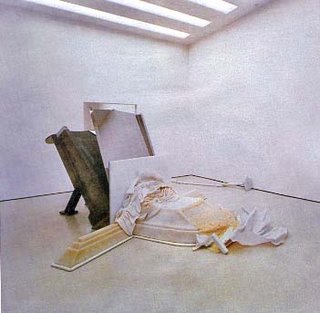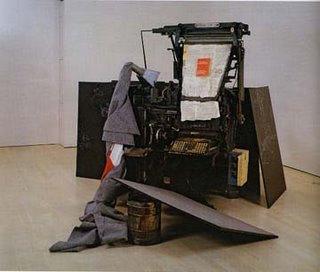
I've been sitting on this post awhile and finally willing to delve into it as there has been some excellent discussion on the nature of Christianity recently on various blogs I enjoy (see recent posts).WAY back in September '06 Modern Painters published a pretty damn good (email) discussion between Matthew Barney and Arthur C. Danto on the legacy of Joseph Beuys and by extension its relationship to Barney's recent sculpture. I gotta confess I'm one of those Cremaster viewers that finds himself nodding off within 10 minutes - Tarkovsky they ain't. I know I;'m supposed to gush at over how importantly obtuse they are but I always feel I've been treated to something a bit sophomoric. They do very little for me but this conversation is about Barney's sculpture (which I generally like) which has turned my head and made me appreciate Barney much more as an object maker and thinker. That Beuys should be on people's minds seems very appropriate for 'these times' and I have to wonder if we will see any here in the States. On a recent trip to Berlin it was a great pleasure to see a ton of works by Beuys at the Hamburger Banhoff Museum.

I'll start with this basic observation by Danto:
There is what we might speak of as the world of Beuys. It is like a mythic overlay on our world, and serves as a kind of moral critique...Barney:
I continue to feel engaged with the problem of making narrative sculpture. Beuys’s oeuvre has one center, whether you consider that center to be Beuys, or if you follow his logic of the sun state. Which sketches his vision of a democratic state of interconnectedness and balance. Somehow that didn’t register for me when I first came across his work. Perhaps its that our current international political and environmental condition that makes one more conscious (and weary) of dominant religious structures. I’m told that the younger generation of German artists is not as interested in Beuys. I’m wondering of models organized with distinct center are less useful to younger people. An artist from Beuys’s generation could align his practice with the more binary philosophies of Hegel or Rudolph Steiner, for example, while an artist from the current generation would naturally gravitate toward something pluralistic, along the lines of Deleuze... my sculpture making system was developed as a tool to navigate through the world, and this tool definitely gives a privileged role to intuition. With this system, I have attempted to create a map of my creative process. This map feels necessary to me. There’s a way in which I fear that I will lose my ability to relocate the fertile point of initiation, the creative impulse that one must always return to, and this fear grows stronger the deeper I delve into any given project. Its narrative is more a proposal, and has an intentionally open-ended structure that invites the audience to complete the story. And as the primary objective of this system is to generate sculpture, the narrative remains abstract – a way to leave space for more specific distillation in the form of sculpture. I believe these ideas are sympathetic with those of Beuys.Danto:
For one thing, it would have never occurred to me that he was projecting a Christian structure. I always thought this message was religious in a diffuse and rather anti-denominational way. He seemed a kind of Druidic presence: ritualistic, shamanistic, primitivistic. Bueys wanted to undo all the technology that separated us from nature. His central thought was healing. He wanted to repeal Modernity, fraternize with animals, live by means of plants, and converse with birds. If he is Christian, he is like St. Francis. I think you and Bueys have a philosophy of salvation in common – overcoming gender boundaries, the human – animal boundaries. I agree that your sculpture making system gives a privileged role to intuition. I wonder whether Beuys would not have said something like that. He would not have used the word ‘system’, I would guess. But he would also not have feared that he would lose the ability to reconnect with his creative impulse. I think that is because he did not think of himself as making art in the first place. He thought he was doing something more important than art. In that way he was practicing a religion of healing, if you believe him, or just believe in him. I am struck by the difference, as I understand it, between sculpture as you think of it, where it is definitely art; and social sculpture, the organization of human beings into an ideal political community, of the kind Faust aspired to establish in the second part of Goethe’s masterpiece.Barney:
Beuys remains a cornerstone of my faith that art can provide useful models and tools for understanding the world, and that these models eventually proliferate into the broader culture and become functional in the collective consciousness. I wouldn’t argue that all art does this, or should do this, but only that it is possible. That said, I’m disappointed Bueys is not so present in the minds of the younger German generation, as this seems like a natural time to reconsider him, given our current ecological and political condition...I guess I think of Beuy’s body as being at the center of his practice. For this reason, I feel like I haven’t had a primary experience with his work, only secondary experiences with the sculpture and documentation of his actions. I accepted that Beuy’s body was a transformer, a conductor, and a transmitter. But this brings me back to the question about a Christian model. If this belief system is about healing and redemption, and if everything must pass through this central body, or transformer, it starts to suggest a Christian character, or at least a Christian structure. Perhaps I’m being too simplistic about this. Again, if this is true, I’m not condemning the work for it, but only wondering if it might suggest a reading that makes the younger generation uneasy.
Danto:
I guess I can see what you mean by Beuy’s body. It was typically present in the work, either when Buey’s was a performer, or when the work referred to Beuys as a physical presence – wounded for example, or teaching while surrounded by blackboards. So his body was transformative. Something passes through it, and that, to you, suggests the analogy of Christ, and ultimately to a Christian relationship between his message and his auditors. That has to be underwritten by his suffering, as Christ’s suffering is the means to our redemption....Maybe the young generation of artists disaffected with Beuys has something to do with the way Beuys made the war so central to his personal myth. I believe, like you, that healing the knife belongs to a much wider vision than its use as a weapon – a vision in which the means and the subject of sacrifice belong to a larger whole. I think the first generation of students were put off by his persistence in art making. German art students in my experience are pretty career oriented. Maybe Beuys was too idealistic to be a model!
Images Modern Painters; Matthew Barney, Joseph Beuys






No comments:
Post a Comment